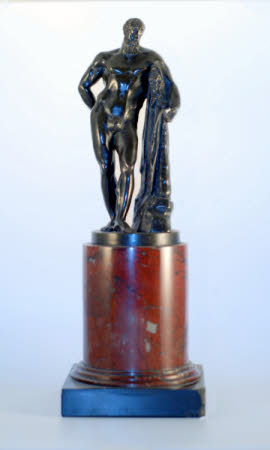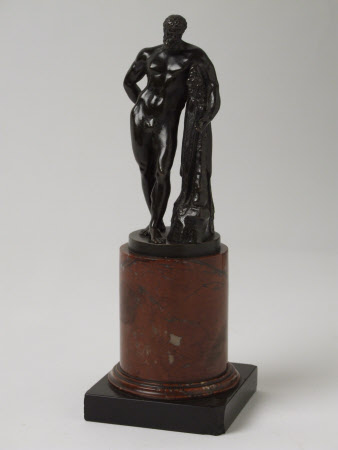Hercules
Category
Art / Sculpture
Date
circa 1820
Materials
Bronze on red marble column and black stone base
Measurements
230 x 83 x 83 mm
Order this imageCollection
Shaw's Corner, Hertfordshire
NT 1274963
Summary
A fine quality bronze statuette of the Farnese Hercules, after the antique marble original in the Museo Nazionale in Naples. Italian, early nineteenth century. Hercules is shown resting, imitated from the antique type, the Farnese Hercules. He stands naked, his left food forwards, leaning under his left arm on a trunk draped with a lion's skin, his left hand held out. His right hand is behind his back, holding a small apple. Bearded type, with a disproportionately small head. On red marble column and black stone base. Cast in Italy in the early nineteenth century.
Full description
A fine quality bronze model of the Farnese Hercules, after the antique marble original in the Museo Nazionale in Naples. Italian, early nineteenth century. Hercules (or Herakles in the Greek version of the myth) is depicted having just slain the Nemean lion, with the iconographic attributes of the lion skin and the apples of the Hesperides. The figure probably originated from Charlotte Shaw’s childhood home of Derry House. (Derry House Inventory, Rosscarbery, dated January 1901. Charlotte took “2 small bronze figures on marble stands” from the dining room there. British Library Add. MS 63198A, f.56). This figure of Hercules is visible in 1904 on the drawing room mantelpiece at 10 Adelphi Terrace, the Shaws’ London home, in a press photograph of Shaw published in The Tatler (16 November 1904, p.242). However the statuette was not listed in the Adelphi Terrace Inventory of 1908, thus it is reasonable to surmise that the object was kept at Shaw’s Corner from November 1906 until Shaw’s death in 1950. Shaw’s appropriation of the Hercules statuette for his mantelpiece may have been prompted by seeing a model of the Farnese Hercules in the rooms of the novelist, philosopher and artist Samuel Butler (whose portrait also features in this room NT 1274690), a man much admired by Shaw. When Shaw visited Butler’s rooms in 1889 at Clifford’s Inn, a statuette of the Farnese Hercules was on view there. A large statuette of this sculpture had featured in Butler’s satirical painting Mr Heatherley’s Holiday: An Incident in Studio Life (1873). (Tate Britain, London, N02761). (Alice McEwan, 2020)
Provenance
The Shaw Collection. The house and contents were bequeathed to the National Trust by George Bernard Shaw in 1950, together with Shaw's photographic archive.
Credit line
National Trust Collections (Shaw’s Corner, The George Bernard Shaw Collection)

